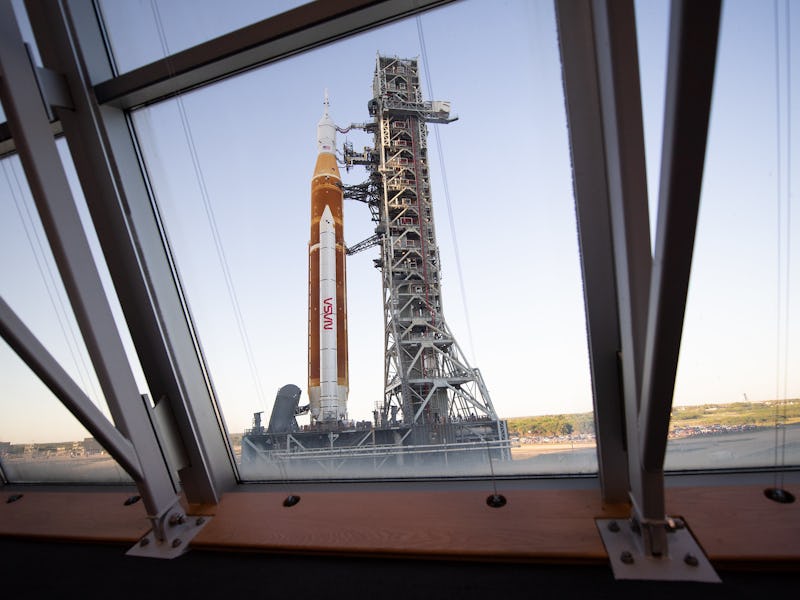NASA SLS vs Starship: Size, launch price, thrust, and capabilities for the ambitious rockets
Here's how NASA’s giant rocket compares with SpaceX's Starship rocket.

NASA is going back to the moon and it has the rocket to do it — the SLS. Meanwhile, Elon Musk and SpaceX are hard at work on their own giant Starship rocket, meant to one day bring humans to Mars. So how do the two compare?
NASA made history in 1969 when Apollo 11 sent humans to the Moon in 1969. It hopes to do the same in 2025 when Artemis 3 sends the first woman and first person of color to the Moon. To do this, it’s going to use a giant, under-development rocket known as the Space Launch System (SLS).
SpaceX has equally lofty goals. The company is testing the Starship, a fully-reusable rocket capable of sending humans to the Moon, Mars, and beyond. But first, SpaceX plans to use the Starship to send Japanese billionaire Yusaku Maezawa and a crew of specially chosen passengers around the Moon. This mission was originally announced in 2018 with a 2023 launch date. However, the Starship has yet to complete an orbital test flight. Meanwhile, NASA took a historic step towards launching the SLS with a “wet dress rehearsal” after rolling out its massive rocket on Friday, March 18.
Despite their different goals, the SLS and Starship serve surprisingly similar purposes — even more surprising when you consider how NASA plans to use the Starship to land the astronauts on the Moon. (SpaceX’s Starship HLS won a $2.89 billion NASA contract in April 2021.)
As these two rockets shoot for the Moon, here’s how they compare.
SLS vs. Starship: How much can it send to the Moon?
Starship HLS.
The SLS comes in six configurations: Block 1, Block 1B, and Block 2, with crew and cargo variants of each.
NASA will use the Block 1 crew variant for Artemis 3.
Here is how much each variant can send to the Moon:
- Block 1 Crew: Over 27 tons (59,500 pounds)
- Block 1 Cargo: Over 27 tons (59,500 pounds)
- Block 1B Crew: 38 tons (83,700 pounds)
- Block 1B Cargo: 42 tons (92,500 pounds)
- Block 2 Crew: Over 43 tons (94,700 pounds)
- Block 2 Cargo: Over 46 tons (101,400 pounds)
The Starship, on the other hand, touts the ability to send over 100 tons (220,000 pounds) to low-Earth orbit and 21 tons to geostationary transfer orbit. SpaceX claims the Starship needs to refuel in orbit to send payloads to the Moon, at which point it can send over 100 tons (220,000 pounds).
SLS vs. Starship: How much thrust do they have?
The SLS produces impressive thrust, but it varies depending on the configuration:
- The Block 1 variant produces 8.8 million pounds
- The Block 1B variant produces 8.9 million pounds
- The Block 2 variant produces 9.5 million pounds
The Starship, on the other hand, will produce 17 million pounds of thrust at liftoff thanks to the Super Heavy booster.
SLS vs. Starship: How tall are they?
The SLS’ Block 1 configuration measures 322 feet tall. The core stages comes in at 212 feet.
The Starship, on the other hand, measures around 400 feet. The ship itself measures 164 feet, while the booster measures 230 feet.
The SpaceX Starship lifting off.
SLS vs. Starship: How much does it cost to launch?
The Space Launch System won’t come cheap. In 2019, Ars Technica reported that it could cost over $2 billion to launch the rocket once in a given year. In March 2022, it emerged it could cost up to $4.1 billion.
In November 2019, Musk claimed a Starship launch could cost just $2 million a turn, thanks to efficiency savings that come from reusing a rocket.
SLS vs. Starship: Where do they launch from?
The Starship is expected to launch from the Starbase facility in Texas, located near the town of Boca Chica.
In December 2021, Musk also confirmed that the ship could lift off from Launch Complex 39A at the Kennedy Space Center in Florida, currently used by SpaceX with the Falcon series of rockets.
Right next door to 39A, NASA will lift off with the SLS from Launch Complex 39B.
SLS vs. Starship: When are the launch dates?
The SLS rocket was originally meant to launch in March but has since been delayed. The “wet dress rehearsal” is continuing through March into April as NASA tests various aspects of the rocket. At the moment, the agency is saying that the earliest launch will be in May, though it could easily be pushed into summer 2022.
As for the Starship, SpaceX is still testing the rocket but Elon Musk claims it will launch sometime in 2022 for an orbital test. Like with the SLS, delays are still possible for the Starship, and getting the rocket to a place where it will be capable of making trips to the Moon or Mars is a ways away.
NASA image of the full SLS.
SLS vs. Starship: Is it reusable?
The SLS is not a reusable system. The Starship, on the other hand, aims to be SpaceX’s first fully-reusable rocket — the Falcon 9 and Falcon Heavy had an expendable second stage.
This is part of the reason why Starship’s flight costs could end out 200 times cheaper per flight. As CEO Elon Musk said in 2019: “A giant reusable craft costs much less than a small, expendable craft.”
SLS vs. Starship: Can it go to Mars?
Yes, both rockets are designed to send humans to Mars.
NASA plans to use its learnings from the Artemis series of missions to better develop its Mars missions, using the Block 1B and Block 2 configurations to complete the missions. SpaceX has an ambitious goal of sending the first humans to the surface sometime in the 2020s.
This article was originally published on